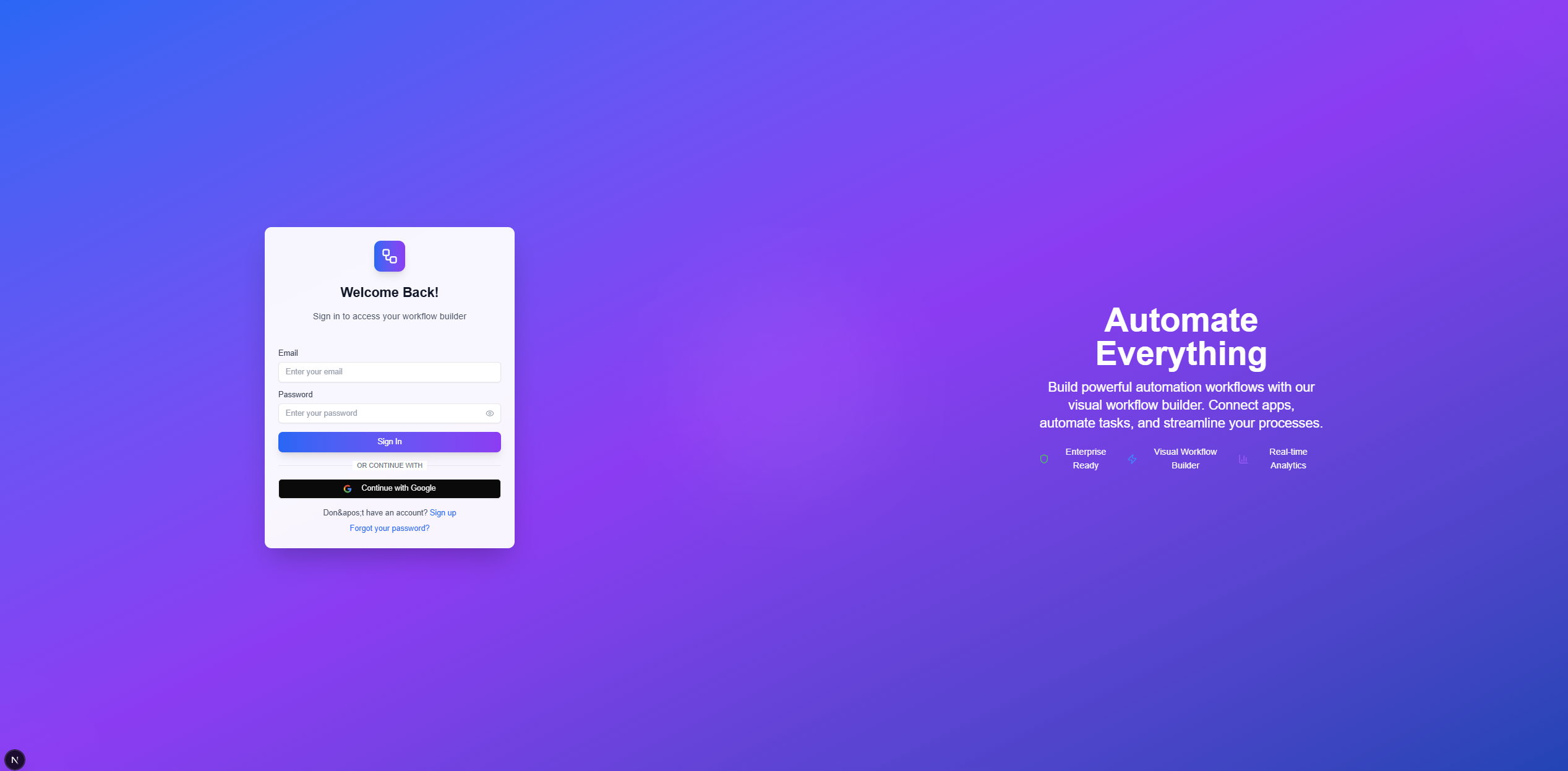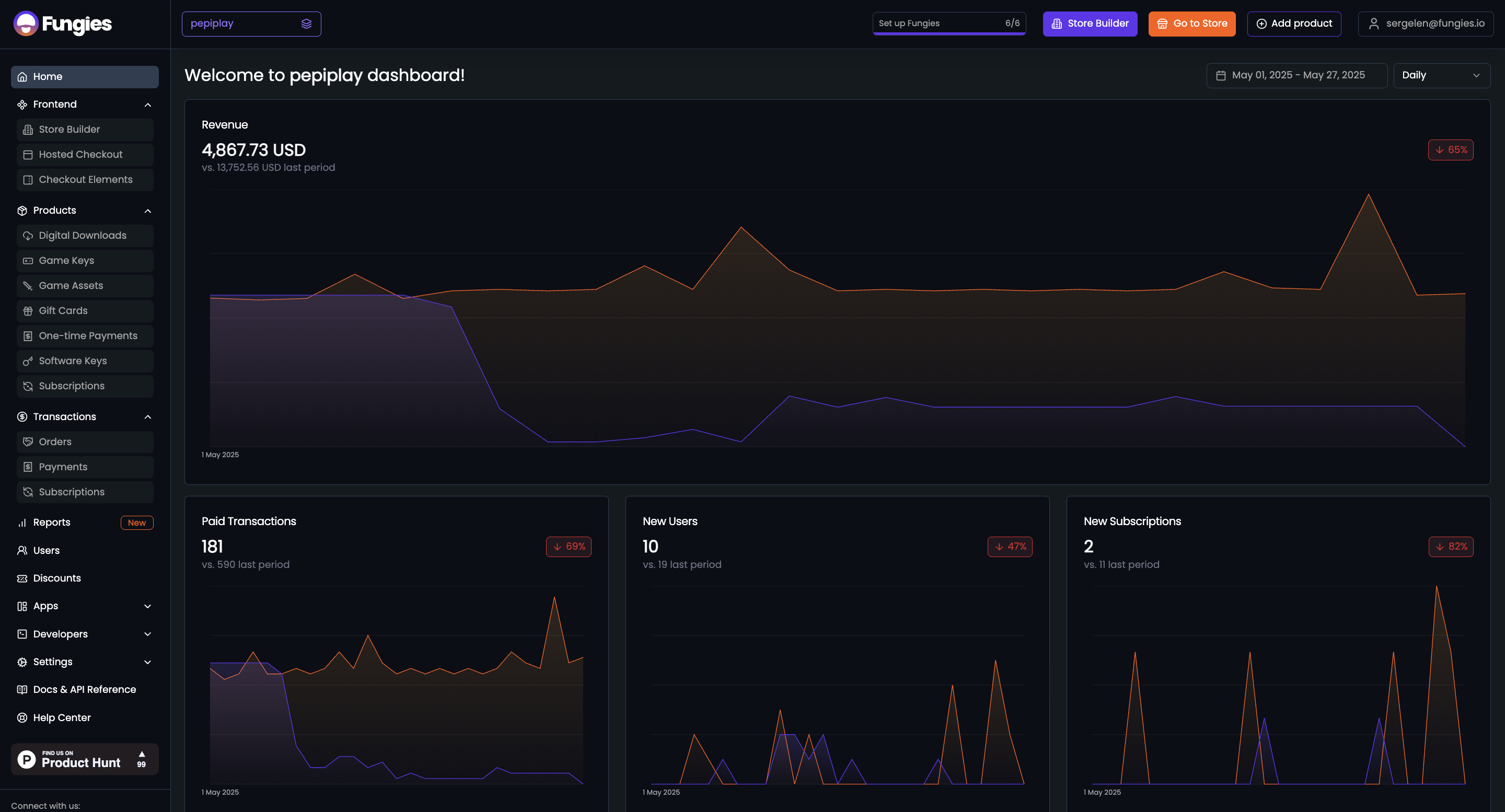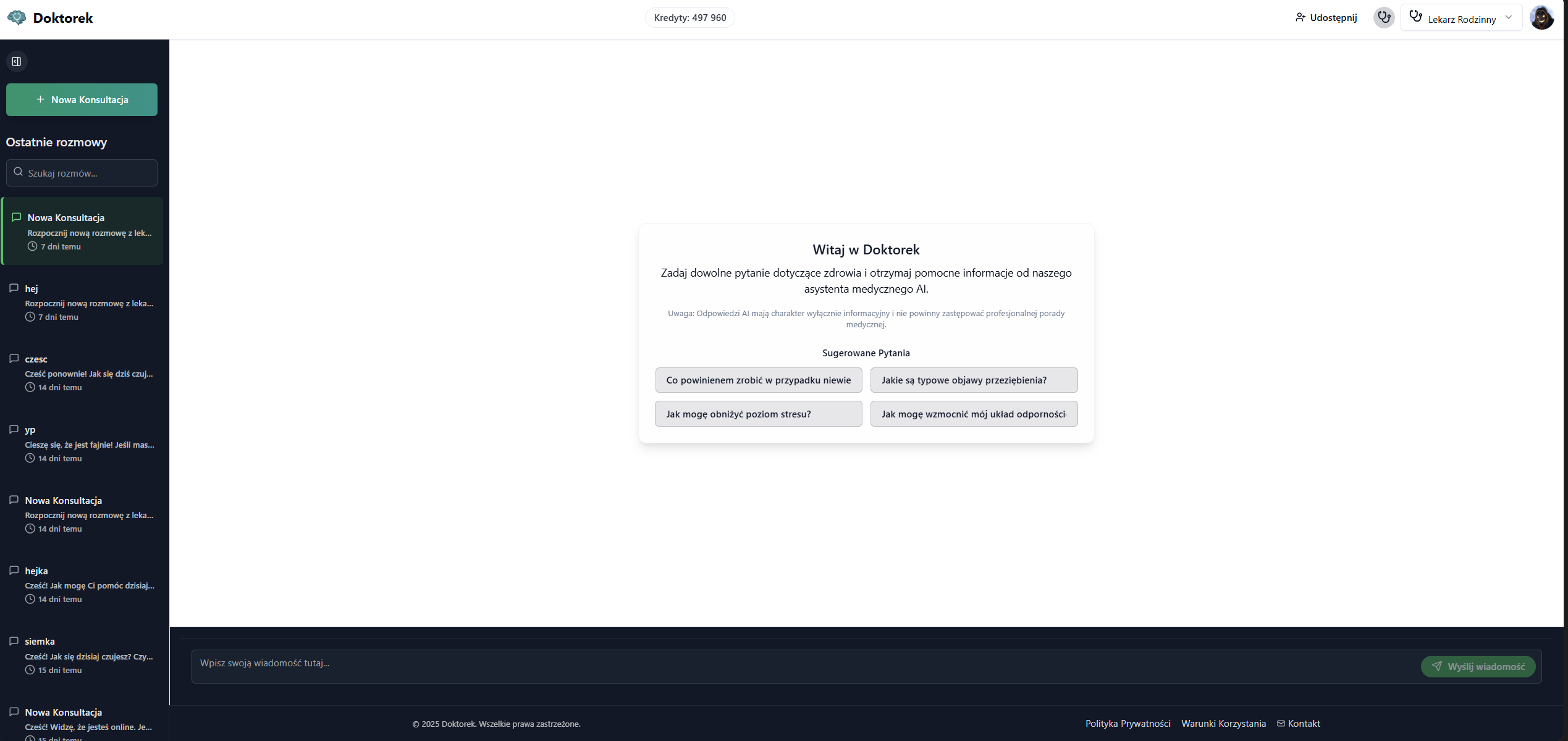In today’s fast-paced digital landscape, the ability to quickly transform ideas into functional products isn’t just a competitive advantage—it’s often a necessity for survival. This is especially true for founders with limited time and resources who need to validate their concepts before making substantial investments. Enter ScrapeBoard, a powerful workflow automation platform that enables users to visually connect nodes and integrate applications to streamline their business processes.
What makes the ScrapeBoard story particularly compelling isn’t just the product itself, but how it came to be. Sweesh.dev, a forward-thinking software agency, managed to take this complex application from concept to working prototype in just seven days—a timeline that would be considered impossible using traditional development approaches. This remarkable achievement was made possible through a combination of modern technology choices, efficient development practices, and strategic use of AI tools to accelerate the MVP development process.
In this case study, we’ll take you behind the scenes of ScrapeBoard’s rapid development journey. We’ll explore how Sweesh.dev leveraged a cutting-edge tech stack including Jotai for state management, NextJS for the frontend framework, ReactFlow for the visual workflow builder, and Prisma with Supabase for the backend infrastructure. More importantly, we’ll reveal how AI tools were integrated throughout the development process to overcome the constraints of limited time and budget while still delivering a polished, functional product.
Whether you’re a future SaaS founder looking to bring your own automation tool to market or a potential client considering rapid prototype development, this case study offers valuable insights into how modern development approaches can dramatically compress timelines without sacrificing quality. The ScrapeBoard project demonstrates that with the right expertise, technology choices, and AI assistance, the traditional rules of software development timelines can be rewritten.
The Client Challenge: Limited Time, Limited Budget, Unlimited Ambition
Behind every successful software project lies a client with a vision—and often, a set of constraints that shape the development approach. For ScrapeBoard, the client was a US-based founder with a clear understanding of what they needed: a powerful workflow automation platform that could compete with established tools like n8n, but with a development timeline and budget that would make most agencies balk.
The founder approached Sweesh.dev with a challenging proposition. They needed a functional prototype that could demonstrate the core value proposition of visual workflow automation, complete with a modern interface and essential integrations. And they needed it fast—not in months or quarters, but in days. With limited funding available for the initial development phase, the traditional approach of assembling a large team for an extended development cycle simply wasn’t an option.
What made this challenge particularly daunting was the complexity inherent in workflow automation platforms. These systems require robust backend infrastructure to handle various API connections, data transformations, and execution logic. They need intuitive frontend interfaces that make complex operations accessible to non-technical users. And they demand reliability, as they often become critical infrastructure for the businesses that adopt them.
Traditional development wisdom would suggest that such a project would require weeks of planning, followed by months of development and testing. The client’s timeline of seven days from concept to working prototype seemed, at first glance, to be unrealistic. But Sweesh.dev saw this not as an insurmountable obstacle, but as an opportunity to demonstrate the power of modern development approaches enhanced by AI assistance.
The client’s constraints actually served as a catalyst for innovation. With the pressure of an extremely tight timeline and budget, the Sweesh.dev team was forced to rethink conventional development processes. They couldn’t afford the luxury of extended planning sessions, multiple rounds of revisions, or the trial-and-error approach that often characterizes software development. Instead, they needed to make smart decisions quickly, leverage existing tools and frameworks effectively, and find ways to accelerate every phase of the development process.
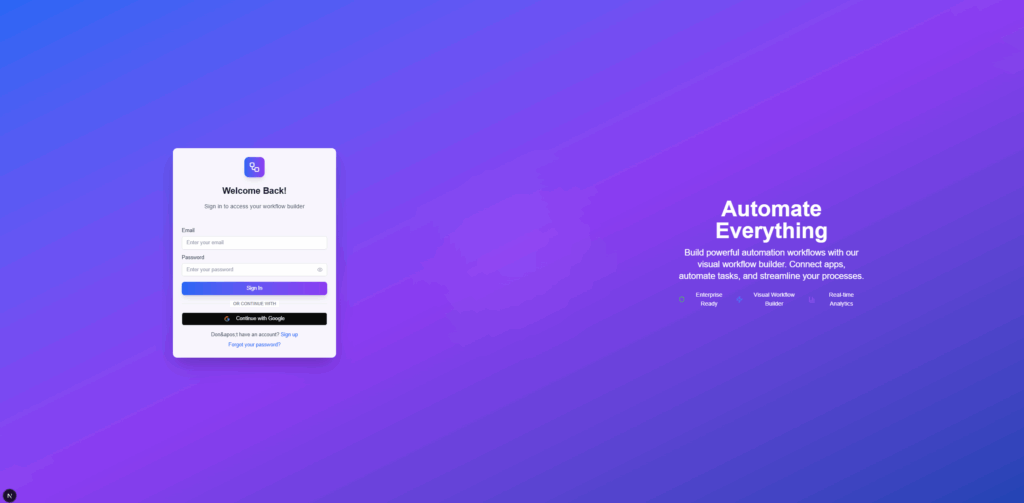
This scenario is increasingly common in today’s startup ecosystem. Founders need to validate their concepts quickly before committing significant resources, and they need agencies that can adapt to these constraints rather than pushing back with traditional timelines. The ScrapeBoard project would become a test case for whether AI-accelerated development could truly deliver on the promise of dramatically compressed development cycles without compromising on quality or functionality.
The Sweesh.dev Approach: Rapid Development Powered by AI
When faced with the daunting challenge of building a complex workflow automation platform in just seven days, Sweesh.dev knew that conventional development methodologies wouldn’t suffice. Instead, they embraced a radical approach that leveraged the latest advancements in AI-assisted development alongside a carefully selected technology stack optimized for rapid iteration.
The first step was to reimagine the traditional software development lifecycle. Rather than spending days on detailed specifications and wireframes, the team adopted a highly collaborative, iterative approach. They began with a single day of intensive planning, during which they worked closely with the client to identify the core features that would deliver the most value in the initial prototype. This focused approach allowed them to avoid the feature creep that often plagues software projects and concentrate their limited time on the elements that would truly demonstrate the platform’s potential.
Central to Sweesh.dev’s strategy was the strategic use of AI tools throughout the development process. Rather than viewing AI as a replacement for human developers, they integrated it as a force multiplier—a way to accelerate repetitive tasks, generate boilerplate code, and solve common problems without extensive research. This approach freed the human developers to focus on the creative aspects of the project, such as user experience design and complex integration logic.
The technology stack was carefully chosen to maximize development speed without sacrificing scalability or user experience. NextJS provided a robust framework for building the React-based frontend, offering benefits like server-side rendering and simplified routing that accelerated development. ReactFlow was selected as the foundation for the visual workflow builder, providing ready-made functionality for creating and connecting nodes that would have taken weeks to develop from scratch.
For state management, the team chose Jotai, a lightweight alternative to Redux that simplified the handling of application state across components. On the backend, Prisma offered type-safe database access with minimal boilerplate, while Supabase provided authentication, real-time database functionality, and storage solutions out of the box. This combination of technologies eliminated much of the infrastructure work that typically consumes the early stages of a project.
The development process itself was structured around twice-daily synchronization meetings, where progress was reviewed, blockers were identified, and priorities were adjusted as needed. This agile approach allowed the team to maintain momentum while ensuring that they remained aligned with the client’s vision. Between these meetings, developers worked in focused sprints, leveraging AI tools to accelerate coding, testing, and debugging.
What made this approach particularly effective was the seamless integration of AI throughout the workflow. Code snippets were generated and refined with AI assistance, UI components were rapidly prototyped using AI design tools, and common integration patterns were implemented with the help of AI-suggested solutions. This didn’t eliminate the need for human expertise—in fact, it elevated its importance, as developers needed to know how to effectively prompt, evaluate, and refine AI-generated content.
Technical Implementation: Modern Stack for Maximum Efficiency
The technical foundation of ScrapeBoard represents a carefully orchestrated symphony of modern web technologies, each selected not only for its individual capabilities but for how seamlessly they work together to enable rapid development without sacrificing scalability or user experience.
At the heart of ScrapeBoard’s frontend is NextJS, a React framework that provided the development team with significant advantages from day one. NextJS eliminated the need to configure complex tooling like webpack or babel, offering out-of-the-box solutions for routing, code-splitting, and server-side rendering. This allowed the developers to focus immediately on building features rather than setting up infrastructure. The framework’s file-based routing system made it particularly well-suited for quickly establishing the application’s core navigation structure, with separate routes for the dashboard, workflow editor, and settings pages.
For the visual workflow builder—the centerpiece of ScrapeBoard’s functionality—ReactFlow proved to be an invaluable choice. This specialized library provided the fundamental capabilities needed for creating, connecting, and manipulating nodes in a visual interface. Rather than spending weeks implementing drag-and-drop functionality, connection validation, and node rendering from scratch, the team was able to leverage ReactFlow’s existing components and customize them to match ScrapeBoard’s specific requirements. The library’s support for custom node types was particularly crucial, allowing the team to create specialized nodes for triggers, actions, and conditions that form the building blocks of automation workflows.
State management in complex applications like ScrapeBoard can quickly become unwieldy, potentially slowing down development as the codebase grows. The choice of Jotai represented a strategic decision to avoid this pitfall. Unlike more verbose state management solutions like Redux, Jotai’s atom-based approach allowed for granular, efficient state management with minimal boilerplate. This proved especially valuable when implementing the workflow editor, where changes to one node might need to trigger updates in connected nodes or in the sidebar configuration panel.
On the backend, the combination of Prisma and Supabase delivered remarkable development velocity. Prisma’s type-safe database client eliminated the need for writing raw SQL queries and provided automatic TypeScript type generation, reducing both development time and potential for errors. Supabase, meanwhile, offered a comprehensive backend-as-a-service solution that handled authentication, database storage, and real-time subscriptions. The ability to leverage Supabase’s pre-built authentication system, complete with social login options, saved days of development time that would otherwise have been spent implementing these features from scratch.
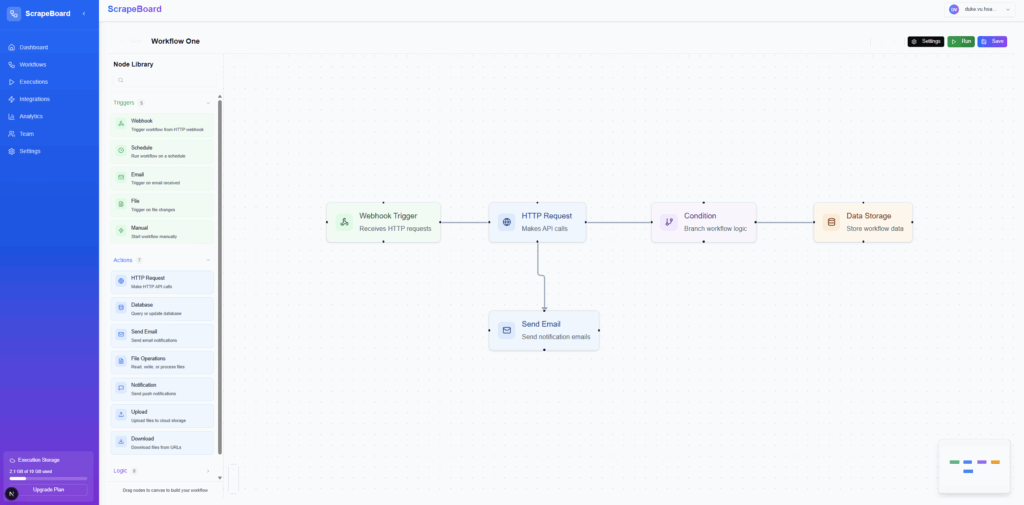
The database schema was designed with both current needs and future scalability in mind. Core entities included Users, Workflows, Nodes, Connections, and Executions, with relationships carefully structured to support the complex interactions between these elements. Prisma’s schema definition language made it straightforward to define these models and their relationships, while its migration system ensured that database changes could be tracked and applied consistently across environments.
API endpoints were implemented using NextJS’s API routes feature, creating a seamless full-stack development experience where backend and frontend code could coexist within the same project. This eliminated the need for CORS configuration and simplified the deployment process. The API was structured around RESTful principles, with endpoints for creating, reading, updating, and deleting workflows, as well as specialized endpoints for executing workflows and managing integrations.
What’s particularly impressive about the technical implementation is not just the individual technologies used, but how they were integrated into a cohesive whole that enabled the rapid development timeline. The team’s expertise in these modern tools allowed them to avoid common pitfalls and leverage each technology’s strengths, while AI assistance helped bridge knowledge gaps and accelerate implementation of standard patterns.
Key Features Showcase: The Power of Visual Workflow Automation
ScrapeBoard’s interface reveals a thoughtfully designed system that balances power and accessibility—a critical achievement for a platform developed in just seven days. The application’s features showcase how Sweesh.dev prioritized creating a functional, intuitive experience that delivers immediate value to users while establishing a foundation for future enhancements.
The main dashboard serves as the command center for users, providing at-a-glance insights into their automation ecosystem. Clean, card-based metrics display total workflows, successful executions, tasks automated, and success rates—all essential data points for users to understand the impact and performance of their automations. The dashboard’s design employs a modern, minimalist aesthetic with a vibrant blue-to-purple gradient that creates visual interest without overwhelming the user. Quick action buttons for creating workflows, viewing executions, managing integrations, and configuring settings provide immediate access to core functionality, eliminating unnecessary navigation steps.
The workflow builder interface represents the heart of ScrapeBoard’s value proposition. Here, Sweesh.dev created a canvas-based environment where users can visually construct automation sequences by connecting nodes that represent triggers, actions, and logic operations. The left sidebar houses a comprehensive node library, organized into logical categories that make it easy to find the right components. Each node features a descriptive icon and clear labeling that communicates its purpose at a glance. The implementation of drag-and-drop functionality feels natural and responsive, allowing users to quickly place nodes on the canvas and establish connections between them.
The node library itself demonstrates impressive breadth for a seven-day build. Trigger options include webhooks for receiving HTTP requests, schedules for time-based automation, email triggers for workflow initiation based on incoming messages, file change monitors, and manual execution options. This variety ensures that workflows can be initiated through virtually any common scenario a user might encounter. Each trigger type includes configuration options that strike a balance between simplicity and flexibility, allowing users to customize behavior without becoming overwhelmed by excessive options.
On the action side, ScrapeBoard offers an equally robust selection of nodes. HTTP request capabilities enable integration with external APIs, while database operations allow for querying or updating connected data sources. Email sending functionality, file operations for reading, writing, or processing files, notification systems, and upload/download capabilities round out the core action set. The implementation of these action nodes reveals careful attention to common use cases, with each node exposing the most frequently needed configuration options while abstracting away unnecessary complexity.
Perhaps most impressive is the inclusion of conditional logic nodes, which allow workflows to make decisions based on data and take different paths accordingly. This feature transforms ScrapeBoard from a simple sequence executor into a true automation platform capable of handling complex business logic. The branch workflow logic node enables if-then-else style decision making, a critical capability for creating workflows that respond intelligently to different scenarios.
The user authentication system demonstrates equal attention to detail and user experience. The login and signup screens feature a clean, accessible design with options for traditional email/password authentication as well as social login through Google. The authentication flow is streamlined and intuitive, with clear error messaging and password recovery options. This polished implementation is particularly noteworthy given the compressed development timeline, as authentication systems are often areas where corners are cut in rapid prototypes.
Throughout the interface, ScrapeBoard maintains consistent design language, with a color scheme dominated by vibrant blues and purples that create a modern, tech-forward aesthetic without sacrificing readability or accessibility. Interactive elements feature subtle but effective hover and active states that provide clear feedback to users, while the overall layout adapts seamlessly to different screen sizes—evidence of responsive design principles applied throughout the application.
The AI-Accelerated Development Process: Redefining What’s Possible
The seven-day development timeline for ScrapeBoard wasn’t just ambitious—it would have been virtually impossible using traditional development methods. What made this rapid timeline achievable was Sweesh.dev’s strategic integration of AI tools throughout the development process, transforming what would typically be weeks of work into days of highly efficient production.
From the very beginning, AI played a crucial role in accelerating the conceptualization phase. Rather than spending days creating wireframes and mockups from scratch, the team used AI design tools to rapidly generate initial interface concepts based on descriptions of the desired functionality and aesthetic. These AI-generated designs weren’t used as final products, but rather as sophisticated starting points that designers could refine and customize. This approach compressed what would typically be a multi-day design process into hours, allowing the team to quickly align on visual direction and move into implementation.
Code generation represented another area where AI dramatically accelerated development. The team leveraged AI coding assistants to generate boilerplate components, standard functions, and common patterns. For example, when implementing the authentication system, developers described the desired functionality to AI tools, which then generated the core authentication logic, form validation, and error handling. Human developers then reviewed, refined, and integrated this code, focusing their expertise on customization and edge cases rather than writing routine implementations from scratch.
This pattern repeated throughout the development process. When creating the node library, developers used AI to generate the base structure for each node type, then customized the implementations for specific functionality. Database models and API endpoints were similarly bootstrapped using AI, with human developers focusing on business logic and integration points. Even CSS styling was accelerated through AI-generated style definitions that were then refined for the specific design requirements.
Testing and debugging also benefited from AI assistance. Automated test cases were generated based on component specifications, while AI debugging tools helped identify and resolve issues more quickly than manual debugging alone would allow. When developers encountered unfamiliar errors or integration challenges, AI provided contextual solutions and examples, eliminating time-consuming research and experimentation.
Documentation, often neglected in rapid development projects, was maintained throughout the process with AI assistance. As features were implemented, AI tools generated initial documentation that developers could quickly review and enhance, ensuring that both internal knowledge and eventual user documentation remained comprehensive despite the compressed timeline.
Perhaps most importantly, AI tools enabled the team to maintain high code quality despite the rapid pace. Code reviews were augmented with AI analysis that identified potential issues, suggested optimizations, and ensured consistency across the codebase. This allowed human reviewers to focus on architectural and business logic concerns rather than catching syntax errors or style inconsistencies.
The effectiveness of this AI-accelerated approach is evident in the numbers: features that would typically take days to implement were completed in hours, and entire subsystems that might require weeks were functional within days. By some estimates, the AI assistance provided a 3-5x productivity multiplier, effectively allowing a small team to accomplish what would traditionally require a much larger development group.
It’s important to note that this wasn’t a case of “AI replacing developers.” Rather, it was a sophisticated human-AI collaboration where each played to their strengths. AI excelled at generating starting points, handling repetitive tasks, and providing information and suggestions, while human developers contributed creativity, judgment, domain expertise, and the ability to integrate disparate elements into a cohesive whole. The result was not just faster development, but development that maintained high standards of quality and innovation despite the compressed timeline.
Results and Business Impact: Delivering Value in Record Time
The ultimate measure of success for any software project isn’t just technical achievement, but the tangible business value it delivers. For ScrapeBoard, the results speak volumes about the effectiveness of Sweesh.dev’s AI-accelerated approach to rapid prototype development.
First and foremost, the project achieved what many would have considered impossible: delivering a functional, polished workflow automation platform in just seven days. This wasn’t a bare-bones prototype with minimal functionality, but a feature-rich application that included all the core capabilities needed to demonstrate the product’s value proposition. The US-based founder received a working product that could be shown to potential investors and early adopters, complete with a professional user interface and robust backend infrastructure.
From a business perspective, this rapid delivery translated into significant advantages for the client. By compressing what would traditionally be months of development into a single week, the founder was able to begin the feedback and validation process much earlier than would otherwise have been possible. This early market entry provided a competitive advantage in the fast-moving workflow automation space, where being first to market with innovative features can be the difference between success and failure.
The cost-effectiveness of the approach was equally impressive. By leveraging AI tools to multiply developer productivity, Sweesh.dev was able to deliver substantially more value within the client’s limited budget than would have been possible using traditional development methods. This efficiency didn’t come at the expense of quality—the resulting application featured a polished user experience, reliable functionality, and a solid technical foundation that could support future growth.
From a user experience perspective, ScrapeBoard successfully delivered on its promise of making workflow automation accessible and intuitive. The visual builder interface eliminated the need for extensive technical knowledge, allowing users to create sophisticated automation workflows through simple drag-and-drop interactions. This accessibility opened up the power of automation to a broader audience, including business users without programming expertise.
The platform’s integration capabilities were particularly valuable from a business impact standpoint. By supporting connections to external services through webhooks and HTTP requests, ScrapeBoard enabled users to automate processes across their entire software ecosystem. This integration potential multiplied the platform’s value, as each new connection point exponentially increased the number of automation scenarios that could be addressed.
Perhaps most importantly, the rapid development approach allowed the client to start gathering real-world feedback almost immediately. Rather than spending months developing in isolation based on assumptions about user needs, the founder was able to put a working product in front of potential users within days. This early feedback loop proved invaluable for refining the product direction and prioritizing future development efforts.
The metrics built into the platform’s dashboard—tracking workflows created, successful executions, and tasks automated—provided tangible evidence of the value being delivered to users. These metrics not only helped users understand the impact of their automation efforts but also gave the founder concrete data points to demonstrate the platform’s effectiveness to potential investors and partners.
For Sweesh.dev, the project served as a powerful case study in the potential of AI-accelerated development. The successful delivery of ScrapeBoard within such tight constraints demonstrated the agency’s ability to leverage cutting-edge tools and methodologies to achieve results that would be impossible through conventional approaches. This success story has become a cornerstone of their client acquisition strategy, attracting other founders and businesses facing similar challenges of limited time and resources.
Lessons Learned: Insights from the Rapid Development Journey
The development of ScrapeBoard wasn’t just a technical achievement—it was a learning laboratory that yielded valuable insights about AI-accelerated development, modern tech stacks, and the art of balancing speed with quality. These lessons have profound implications for future SaaS founders and development teams facing similar challenges.
One of the most significant revelations was the importance of strategic scope management. Rather than attempting to build a comprehensive platform with every conceivable feature, Sweesh.dev worked closely with the client to identify the core functionality that would deliver the most immediate value. This ruthless prioritization was essential to meeting the seven-day timeline. The team focused on implementing a solid foundation of trigger types, action nodes, and conditional logic that would enable the most common automation scenarios, while deferring less critical features to future development phases.
The project also highlighted the critical role of technology selection in enabling rapid development. The chosen stack—NextJS, ReactFlow, Jotai, Prisma, and Supabase—proved to be remarkably synergistic, with each technology addressing specific needs while integrating seamlessly with the others. This experience reinforced the value of staying current with modern development tools and frameworks, as the productivity gains they offered were substantial compared to more traditional approaches.
Perhaps the most transformative lesson came from the integration of AI throughout the development process. The team discovered that AI tools were most effective when used not as replacements for human developers, but as amplifiers of human creativity and problem-solving. The most productive workflow emerged when developers learned to craft effective prompts, critically evaluate AI-generated outputs, and seamlessly integrate AI assistance into their existing development practices. This human-AI collaboration model represents a new paradigm that dramatically expands what small teams can accomplish.
The project also revealed important insights about team dynamics in AI-accelerated development. Traditional role boundaries became more fluid, with developers sometimes stepping into design roles and designers contributing to implementation decisions. This cross-functional collaboration was enabled by AI tools that lowered the technical barriers between disciplines, allowing team members to contribute more broadly than their specific expertise might traditionally allow.
Communication proved to be even more critical in the compressed timeline than in conventional projects. The twice-daily synchronization meetings were essential for maintaining alignment and quickly addressing blockers. The team found that these frequent, focused check-ins were far more effective than longer, less frequent meetings would have been, allowing for rapid course corrections and preventing misalignments from derailing progress.
The experience also highlighted some challenges inherent in rapid, AI-assisted development. The team encountered occasional instances where AI-generated code required significant refinement to meet performance or security standards, reinforcing the importance of human oversight and expertise. They also found that certain complex or highly specialized features still required substantial human development effort, suggesting that AI assistance offers variable benefits depending on the specific task at hand.
Documentation emerged as a potential pitfall in rapid development, with the team discovering that even AI-assisted documentation generation required careful review to ensure accuracy and completeness. This led to the implementation of a “document as you build” approach, where features weren’t considered complete until their documentation was finalized, preventing the documentation debt that often accumulates in fast-paced projects.
Perhaps most importantly, the ScrapeBoard project demonstrated that quality and speed need not be mutually exclusive. By leveraging modern tools, embracing AI assistance, and maintaining disciplined development practices, the team was able to deliver a polished, professional product despite the compressed timeline. This challenges the conventional wisdom that rapid development necessarily results in technical debt or compromised user experience.
Future Roadmap: Building on a Solid Foundation
While ScrapeBoard’s initial prototype already delivers impressive functionality, the platform’s architecture was designed with future growth and enhancement in mind. The roadmap for ScrapeBoard reflects both the immediate opportunities for expansion and the longer-term vision for the platform’s evolution.
In the near term, expanding the library of pre-built integrations represents the most immediate opportunity for increasing ScrapeBoard’s value proposition. Plans include adding direct connections to popular services like Slack, Google Workspace, Microsoft 365, Salesforce, and other widely-used business applications. These native integrations would simplify the connection process compared to the current HTTP request approach, making the platform more accessible to users with limited technical knowledge.
The workflow execution engine is another area slated for enhancement. Future versions will introduce more sophisticated error handling capabilities, including automatic retries with configurable backoff strategies, detailed error logging, and the ability to define custom error handling paths within workflows. These improvements will increase the reliability of automations, particularly for mission-critical business processes.
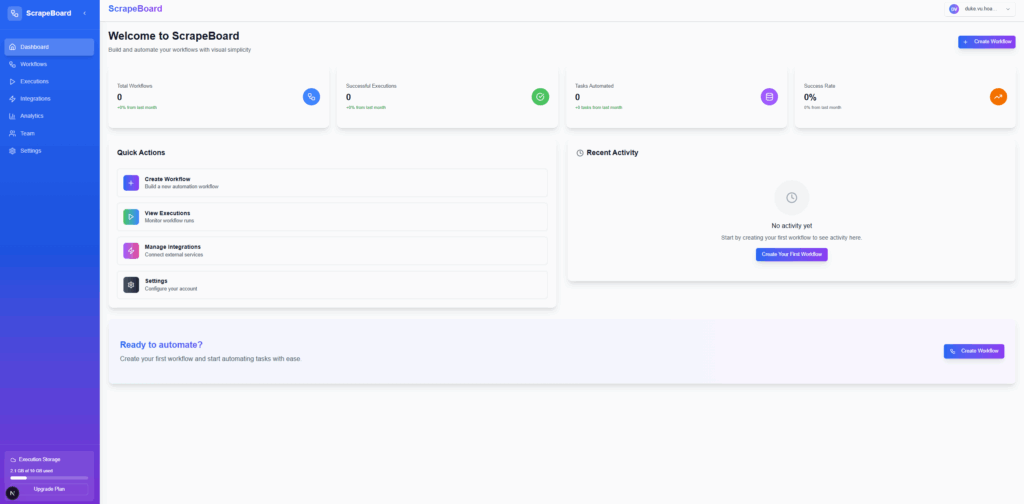
Data transformation capabilities represent another key area for expansion. While the current version allows for basic data manipulation, future releases will introduce dedicated transformation nodes that enable more complex operations like filtering, mapping, aggregation, and format conversion. These enhancements will allow users to build more sophisticated workflows that can handle complex data processing requirements without resorting to custom code.
User experience improvements are also high on the roadmap. Planned enhancements include a template gallery featuring pre-built workflows for common automation scenarios, a more advanced workflow debugger with step-by-step execution visualization, and improved collaboration features that allow teams to work together on workflow development. These features will make the platform more accessible to new users while providing the depth needed for power users.
From a technical perspective, performance optimization is a priority for future development. As workflows become more complex and execution volumes increase, enhancements to the execution engine will ensure that ScrapeBoard maintains its responsiveness and reliability. This includes implementing more efficient data processing algorithms, optimizing database queries, and introducing caching mechanisms where appropriate.
Security and compliance capabilities will also be expanded to meet the needs of enterprise customers. Future versions will introduce more granular permission systems, audit logging, and compliance features designed to satisfy regulatory requirements in various industries. These enhancements will open up new market opportunities in sectors with stringent data handling requirements.
The longer-term vision for ScrapeBoard includes expanding beyond simple automation into more advanced territories. Plans include introducing AI-powered workflow suggestions that can analyze existing business processes and recommend automation opportunities, predictive analytics capabilities that can forecast workflow performance and identify potential bottlenecks, and natural language interfaces that allow users to describe desired automations in plain English.
Mobile accessibility is another area of future focus, with plans for both responsive web interfaces and dedicated mobile applications that allow users to monitor and manage their automations on the go. These mobile capabilities will be particularly valuable for workflows that require human approval steps or that need to be triggered from field locations.
Throughout this evolution, maintaining the core principles that made the initial prototype successful remains a priority. The platform will continue to emphasize visual simplicity, intuitive design, and accessibility to non-technical users, even as its capabilities grow more sophisticated. This balance between power and simplicity will remain ScrapeBoard’s defining characteristic as it evolves from promising prototype to mature platform.
Conclusion: Redefining What’s Possible in SaaS Development
The ScrapeBoard project stands as a compelling testament to what’s possible when innovative development approaches meet modern technology and AI assistance. In just seven days, Sweesh.dev transformed a concept into a sophisticated workflow automation platform that rivals established competitors—an achievement that challenges conventional wisdom about software development timelines and possibilities.
For future SaaS founders, the lessons from this case study are invaluable. The traditional approach of spending months building a perfect product before market entry is increasingly being replaced by rapid, iterative development that prioritizes early feedback and validation. ScrapeBoard demonstrates that with the right expertise, technology choices, and AI assistance, even complex platforms can be brought to market in timeframes previously considered impossible. This accelerated path to market not only conserves precious startup resources but also provides a competitive edge in fast-moving technology sectors.
The project also highlights the transformative potential of AI in the development process. We’re entering an era where AI isn’t just the product being built, but an integral part of how we build products. The human-AI collaboration model pioneered by Sweesh.dev represents a new paradigm that dramatically expands what small teams can accomplish, democratizing access to sophisticated development capabilities that were previously available only to large organizations with substantial resources.
For potential clients considering their own software development projects, ScrapeBoard offers a new perspective on what’s possible. The constraints that once seemed limiting—tight timelines, modest budgets, complex requirements—can now be viewed through a different lens. With partners who embrace modern development approaches and AI assistance, these constraints become challenges to overcome rather than roadblocks to progress.
Perhaps most importantly, the ScrapeBoard story demonstrates that speed and quality need not be mutually exclusive. The resulting platform isn’t just functional—it’s polished, intuitive, and built on a solid technical foundation that can support future growth. This challenges the notion that rapid development necessarily results in technical debt or compromised user experience.
As we look to the future, the approach pioneered in the ScrapeBoard project points toward a new model of software development—one that’s more accessible, more efficient, and more responsive to market needs. By embracing modern tools, leveraging AI assistance, and maintaining a relentless focus on delivering value, development teams can achieve results that would have seemed impossible just a few years ago.
For Sweesh.dev, the successful delivery of ScrapeBoard within such tight constraints isn’t just a technical achievement—it’s a blueprint for future projects and a powerful demonstration of their capabilities. By continuing to refine and evolve their AI-accelerated development approach, they’re positioned to lead in an era where the ability to rapidly transform ideas into reality is perhaps the most valuable skill a technology partner can offer.
The journey from concept to working prototype in seven days is just the beginning for ScrapeBoard. With a solid foundation in place and a clear roadmap for future enhancements, the platform is well-positioned to grow into a powerful tool that helps businesses of all sizes harness the potential of automation. But beyond the product itself, the story of how it came to be serves as an inspiration and a challenge to the software development community—a reminder that with the right approach, we can redefine what’s possible.
